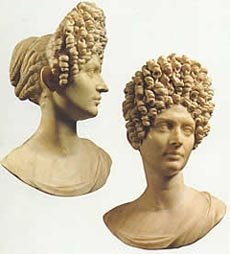
Hairstyle in Greece It varied according to the times, the fashion, the different cities and the different social classes. There was a lot of difference between Sparta and Athens.
En Sparta children wore their hair cropped and adults wore it long. On Athens It was the other way around, children had long hair, adults had short hair and slaves had shaved hair.
In archaic times, ladies wore long hair, with heavily braided hairstyles around the entire head and very elaborate. As testimony we have the frescoes from the Minoan period, we find them in the decorations of the ceramics, in the decoration of the coins, you can also see the different hairstyles both in men and women observing the different sculptures. Very important sculptures in which the hairstyle can be well appreciated, it is in the Discobolus, the head of Apollo, the head of Zeus.
In classical times ladies hairstyles, it is still very elaborate, and very collected with many ribbons, curly or wavy hair.
If we look at the friezes, ceramics and sculptures we see the hairstyle of men in various ways, as well as the difference of the beard. The fundamental thing for the Greeks was to wear curly hair for both men and women. They used oils and pomades to put together the hairstyle and held it up with bobby pins.
Currently, when ladies want to have a Greek-style hairstyle, they do it with curly or wavy hair, collected or semi-collected, very elaborate with some flower in the collected, with some ribbons, you can add a braid between the collected or around the head.
the greek hairstyles that you showed me were not so cute for the next one or to make them better
VAI!
The photo corresponds to the typical Roman hairstyle, which was used to make it a frame, investigate better.
photography will not be the most successful as a reference, but neither should it be dramatized, in the National Museum of Archeology in Athens there are many examples to assess.